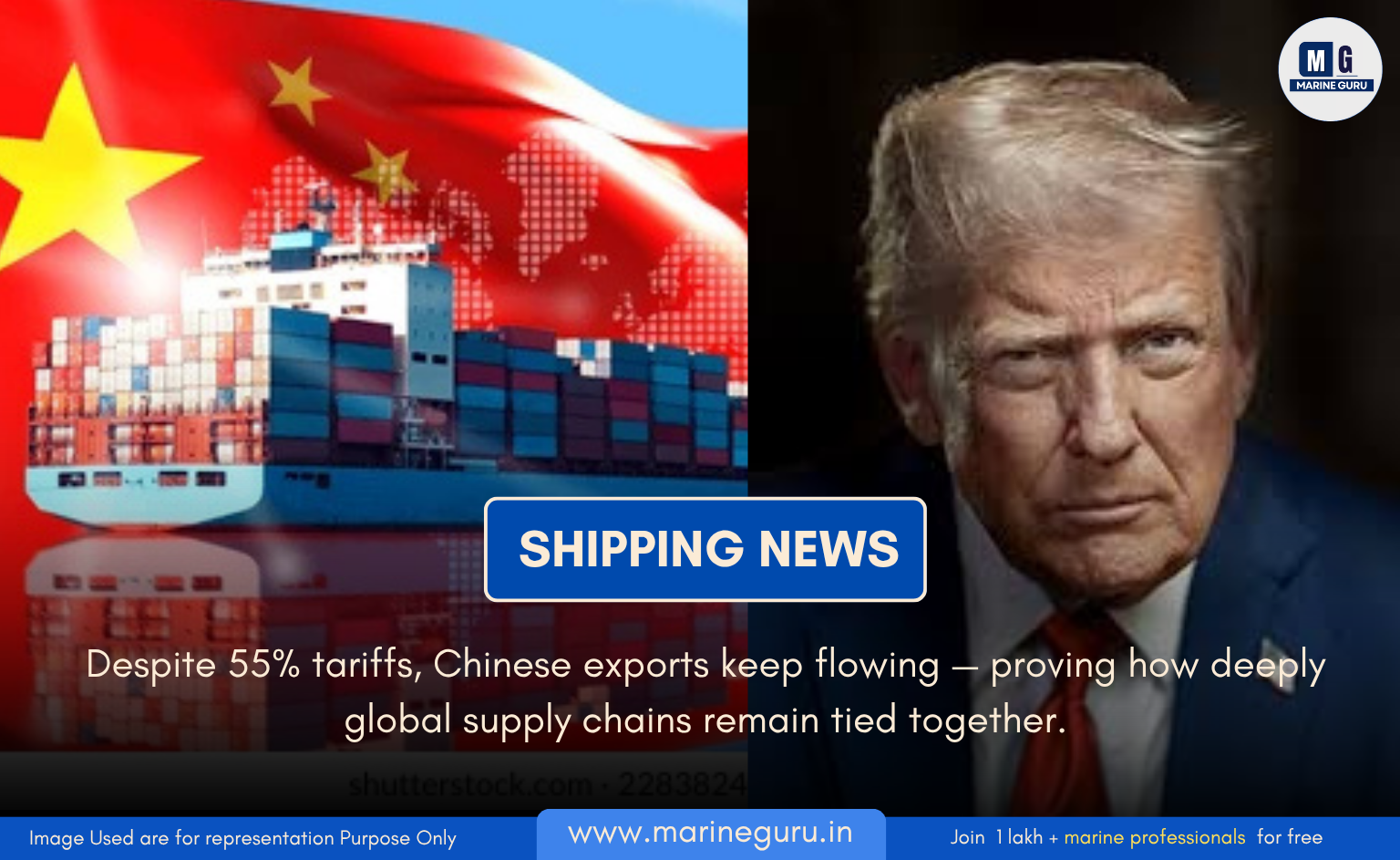“Tariffs Can’t Stop the Tide” — How Chinese Exports Still Power Global Trade Despite Trump’s 55% Tariffs

Originally reported by Bloomberg News (Oct 22, 2025) and featured on gCaptain.
Simplified and rewritten for clarity by MarineGuru (www.marineguru.in).
A Trade War That Refuses to Sink
Six months into former President Donald Trump’s renewed trade war, one thing has become clear: Chinese exports are still sailing strong — billions of dollars worth every day.
Despite 55% US tariffs, container ships continue to cross the Pacific carrying smartphones, copper, e-bikes, and essential electronics — products that remain the backbone of global supply chains.
The trade lanes between China and the US were expected to slow under tariff pressure. Instead, they’ve revealed how deeply interconnected the world’s two largest economies remain, at least in the near term.
The Numbers Behind the Waves
According to data cited by Bloomberg and gCaptain, the value of Chinese goods arriving at US ports in the third quarter of 2025 exceeded $100 billion, keeping Beijing’s export economy on track for its growth targets.
Even as overall trade between the two nations dipped in value over the past six months, exports of key products — from refined copper to e-bikes and e-cigarettes — actually increased compared to 2024 levels.
Economists Chang Shu and David Qu from Bloomberg Economics wrote that “China’s strong position in global supply chains gives it bargaining power with US importers,” adding that “realigning production will take time.”
What Happened — In 3 Key Points
- Tariffs Meet Reality:
Despite a 55% tariff wall, China shipped over $100 billion in goods to the US in Q3 2025. Electronics, metals, and components remain irreplaceable for American industries. - Loopholes & Workarounds:
Importers are minimizing tariff costs by trans-shipping via Vietnam or Mexico and undervaluing goods through “first sale” pricing at customs. - Trade Shifts, Not Collapse:
While exports of game consoles and LCD TVs plunged, shipments of refined copper cathodes, cables, and e-bikes surged — showing adaptation, not retreat.
A Supply Chain That Refuses to Break
Experts note that China’s dominance in rare earths, magnets, and key chemical components gives it short-term leverage, even as the US aims to diversify.
This resilience strengthens Beijing’s hand in ongoing tariff talks, as negotiators push to extend the 90-day truce due to expire in November.
The July–September trade surplus rose to $67 billion, giving China both political and economic breathing room amid the standoff.
Cracks in the Tariff Wall
As reported by gCaptain, US importers are exploiting loopholes in tariff enforcement.
By routing goods through third countries or declaring lower customs values, many are avoiding full tariffs.
Zhaopeng Xing, senior strategist at ANZ Bank, told Bloomberg that “there are a lot of loopholes” — and that US Customs lacks the manpower to police them effectively.
Meanwhile, e-commerce remains a strong current: despite the closure of the duty-free “de minimis” rule in May, American consumers have bought $5.4 billion worth of Chinese small parcels via Shein and Temu.
Business-to-business online exports jumped from $31 million in August to $201 million in September, suggesting that Chinese exporters are shifting to bulk shipments that are unpacked domestically in the US.
The Shifting Cargo Mix
While exports of gaming consoles and TVs have fallen sharply — companies like Nintendo and Microsoft now ship from Vietnam to avoid tariffs — shipments of electrical cables and refined copper have soared.
Trump’s push for onshoring and domestic manufacturing could reshape long-term trade volumes, but for now, the Pacific shipping lanes remain busy.
The maritime sector continues to carry the burden of global trade tensions, with freight rates and routing strategies adapting to political uncertainty.
The Wake Left Behind
Even amid political storms, the sea finds its way.
The current trade conflict shows that global trade doesn’t stop — it reroutes.
For shipowners, freight forwarders, and seafarers, this means more complexity and compliance risk — from trans-shipment routes to origin declarations.
Shipping remains the silent enabler of world trade — a bridge between two economies that cannot fully separate.
#TradeWar #ChinaExports #USChinaTrade #GlobalShipping #MaritimeEconomy #MarineGuru #Bloomberg #gCaptain



